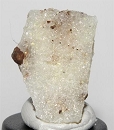
|
| Nitratine |
Chemical
Formula |
NaNO3 |
Species |
Nitrates |
Crystal
System |
Trigonal |
Mohs
Scale |
1-2 |
Color |
Colourless, white, lightly tinted by impurities (red-brown, grey, yellowish); colourless in transmitted light |
Luster |
Vitreous |
Refractive
Index |
n = 1.330 - 1.336 n = 1.580 - 1.587 |
Diaphaneity |
Transparent |
Cleavage |
PerfectOn perfect; on and reported as imperfect. |
Fracture |
Conchoidal |
| Crystal Habit:Crystals rhombohedral . Massive granular, incrustations. |
| Geological Setting:Surficial deposits in arid regions; efflorescences on soils, or in sheltered environments. |
Nitratine (also
nitratite), also known as
cubic niter (UK:
nitre),
soda niter or
Chile saltpeter (UK:
saltpetre), is a mineral, the naturally occurring form of sodium nitrate, NaNO
3. Nitratine crystallizes in the trigonal system, but rarely occurs as well formed crystals. It is isostructural with calcite. The typical form is as coatings of white, grey to yellowish brown masses. It is quite soft and light with a Mohs hardness of 1.5 to 2 and a specific gravity of 2.24 to 2.29. Its refractive indices are nω=1.330 - 1.336 and nε=1.580 - 1.587. The rare crystals when found typically have the scalenohedral form of the calcite structure.
It is found only as an efflorescence in very dry environments. It is very soluble in water such that it is deliquescent and will absorb water out of the air and turn into a puddle of sodium nitrate solution when exposed to humid air.
It has been known since 1845 from occurrences in the Confidence Hills, southern Death Valley, California and the Atacama desert, Chile.


 YueGongAnBei 44051102000467
YueGongAnBei 44051102000467


 |
|